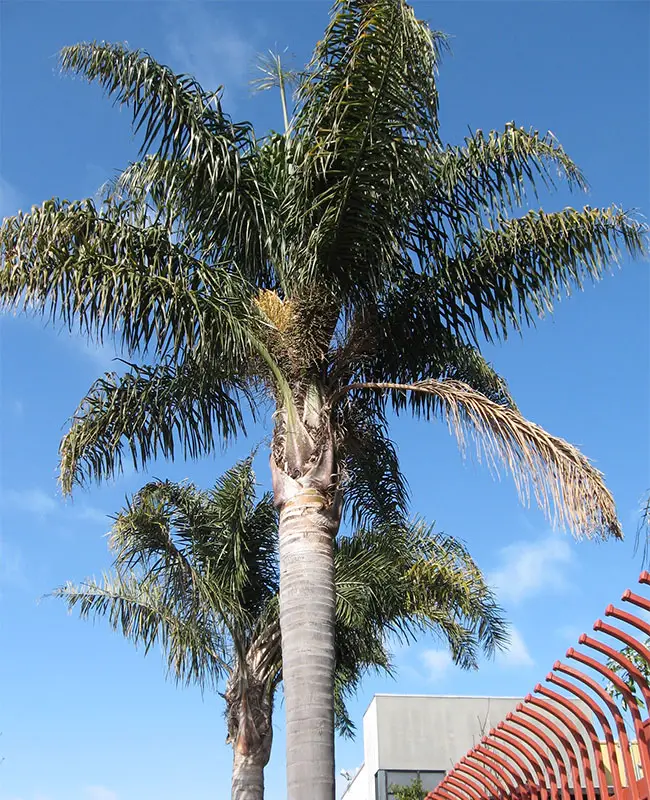
When it comes to creating an outdoor tropical oasis, many homeowners are often in search of fast-growing palm trees. These trees not only help save money but also accelerate the process of attaining a lush overhead canopy.
Larger palm trees excel in providing shade around the pool area or offering sun and wind protection to more delicate plants underneath.
While certain palm species are known for their rapid growth, it’s important to note that the key factor lies in the growing conditions.
For instance, if you were to purchase a fast-growing palm and plant it in South Carolina, it would inevitably grow at a slower pace than the same palm planted in Florida. As the climate becomes increasingly tropical, your palm tree will thrive and grow at a faster pace.
Furthermore, the use of fertilizer is another crucial factor that can significantly expedite the growing process of your palm tree. Check out my detailed post on what fertilizer to use and when to fertilize your palms.
While there are numerous fast-growing palm species across the world, it’s important to note that some of these may be rare and challenging to locate.
In this post, I wanted to provide you with a list of the most popular fast-growing palm species that are readily available, both at your local nursery and online.
1. Acai Palm Tree (Euterpe oleracea)
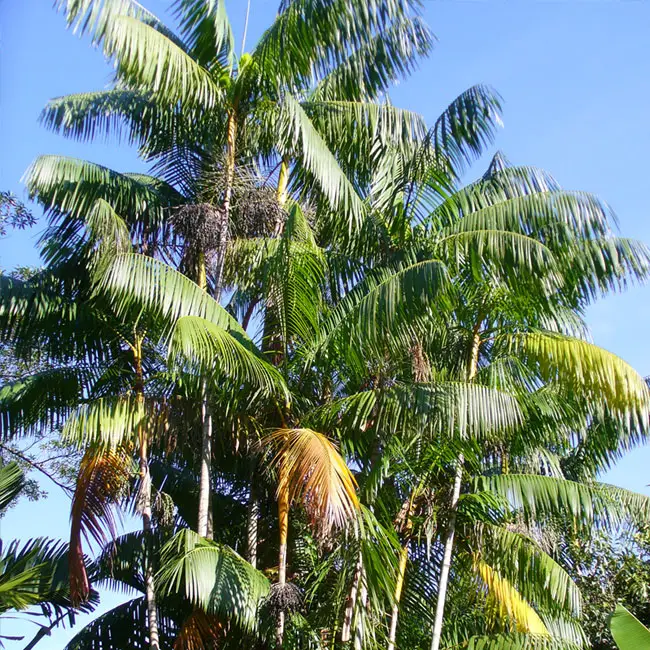
The Acai Palm Tree, scientifically named Euterpe oleracea, originates from Brazil and the northern coast of South America. Renowned for its delicious fruits used in the production of jams, energy drinks, and weight loss products, this palm tree thrives in regions with abundant moisture.
However, it is important to note that it does not do well in dry conditions, so be sure to provide it with ample water. This elegant palm exhibits remarkable growth speed.
In the right environment, it can reach heights of 40 to 50 feet and spread to dimensions of 30 to 40 feet, boasting an impressive growth rate of approximately 1.5 feet per year.
2. California Fan Palm Tree (Washingtonia filifera)
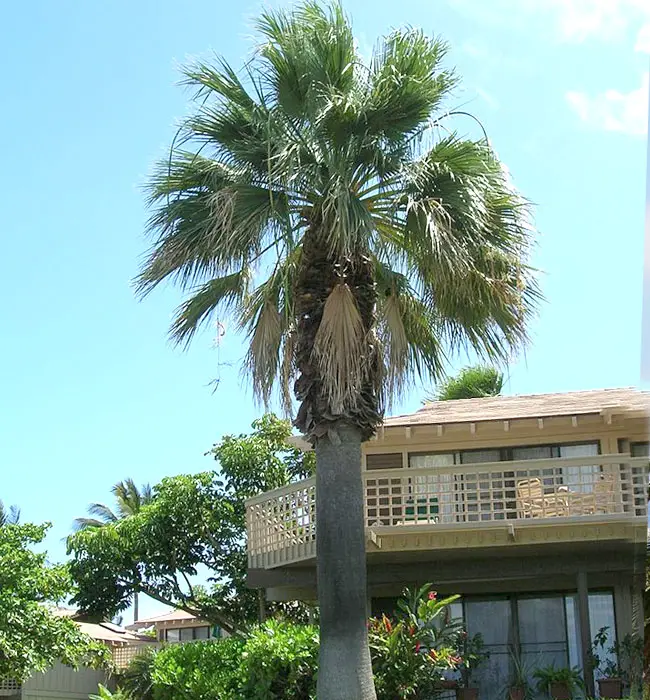
The California Fan Palm Tree, scientifically known as Washingtonia filifera, is native to North America. This hardy palm thrives in well-drained soil with either an acidic or alkaline pH.
It exhibits remarkable resilience, withstanding cold temperatures as low as 10°F and showcasing an impressive drought tolerance.
Though it may not grow as rapidly as the Mexican fan palm, it still falls into the category of moderately fast growers, especially when compared to the growth rates of other popular palm species.
In optimal conditions, it can reach heights of up to 50 feet and spans approximately 15 feet in width, boasting an annual growth rate of about 1 foot per year.
3. Carpentaria Palm Tree (Carpentaria acuminata)
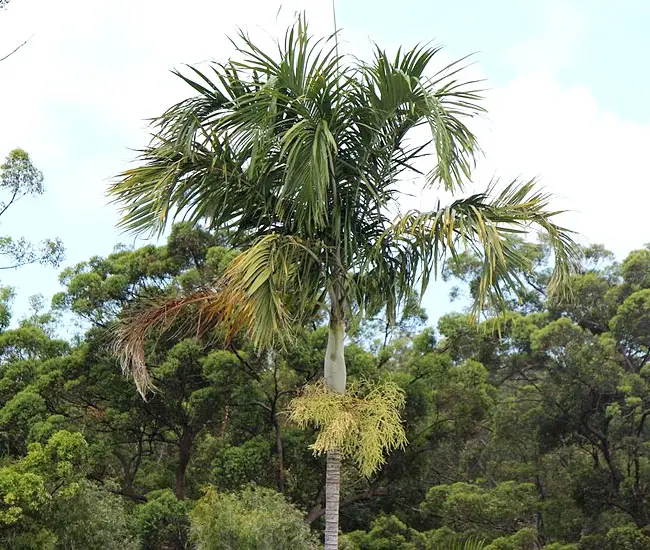
The Carpentaria Palm Tree, scientifically known as Carpentaria acuminata, is a highly sought-after fast-growing palm native to the rainforest regions of Australia.
It thrives in wet conditions, although it can withstand some periods of drought. Once mature, it can endure cold temperatures down to 35°F for brief periods but is not particularly salt-tolerant.
This palm tree thrives in warm tropical climates and exhibits accelerated growth in South Florida compared to Southern California.
It has the potential to reach heights of 30 to 40 feet and spans 10 to 15 feet in width, with an impressive growth rate of 3 feet per year.
4. Foxtail Palm Tree (Wodyetia bifurcata)
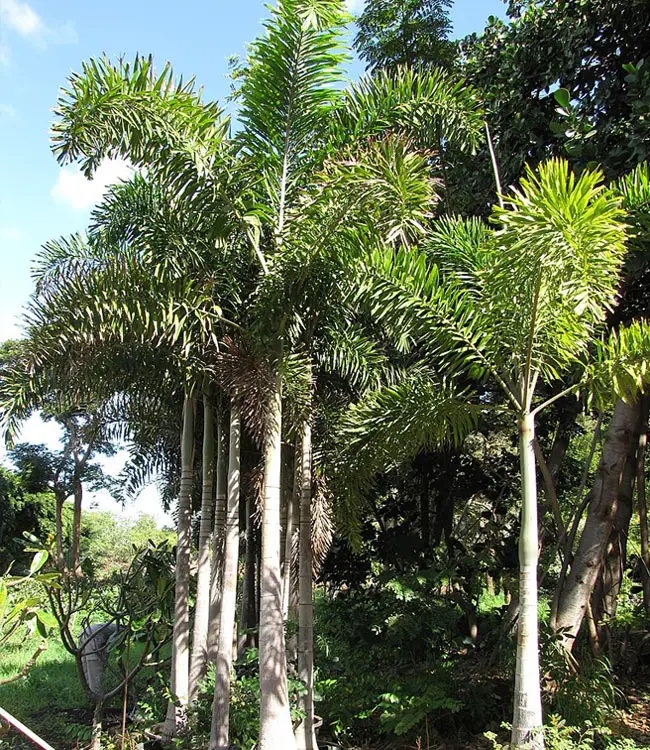
The Foxtail Palm Tree, scientifically named Wodyetia bifurcata, is yet another fast-growing palm that has gained popularity due to its stunning foliage. Native to Australia, it was only discovered in the early 1980s.
This resilient palm can adapt to a wide range of soil conditions, including alkaline limestone soils and rocky sands.
To ensure vigorous growth, it requires regular watering and fertilization, as well as full sun exposure and well-drained acidic soil. It has the potential to reach heights of 20 to 30 feet and a width of 15 feet, with a growth rate of about 1.5 feet per year.
5. King Palm Tree (Archontophoenix cunninghamiana)
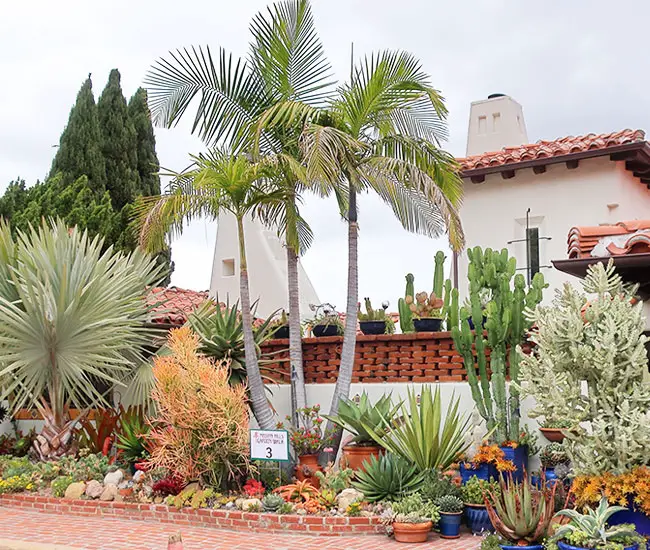
King Palm Tree, scientific name Archontophoenix cunninghamiana, stands out as one of the most favored palms in tropical and subtropical climates. It flourishes in acidic soil when provided with full sun exposure and regular watering, but it won’t thrive in alkaline soil.
Native to Australia, this palm tree exhibits rapid growth, soaring to heights of 40-50 feet and spanning 10-15 feet in width, with an impressive growth rate of 2 feet per year. In favorable conditions, you can witness a 25-foot palm tree in just 10 years.
While this palm is undeniably striking as a standalone specimen, it also adds appeal when underplanted with low groundcover.
6. Majesty Palm Tree (Ravenea rivularis)
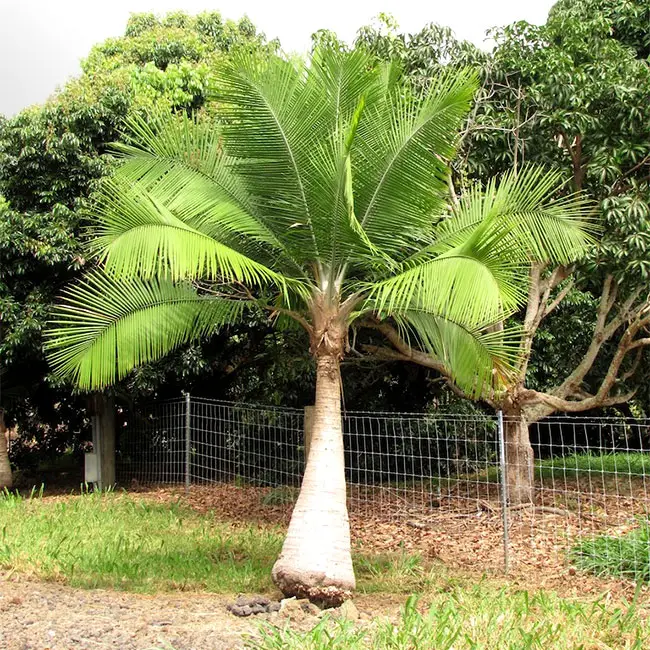
The Majesty Palm, scientifically named Ravenea rivularis, originates from Madagascar. It’s an ideal choice for planting near water features, although it’s important to note that it doesn’t tolerate salt.
While it exhibits adaptability to a wide range of soils, thriving equally well in both alkaline and acidic conditions, it particularly favors consistently moist surroundings and doesn’t do well in drought. Once it reaches maturity, it can withstand brief cold spells down to 25°F.
With the right nutrients provided, this fast-growing palm has the potential to reach impressive heights of 40-50 feet and spans 5-10 feet in width, boasting a growth rate of 1.5 feet per year.
7. Mexican Fan Palm Tree (Washingtonia robusta)
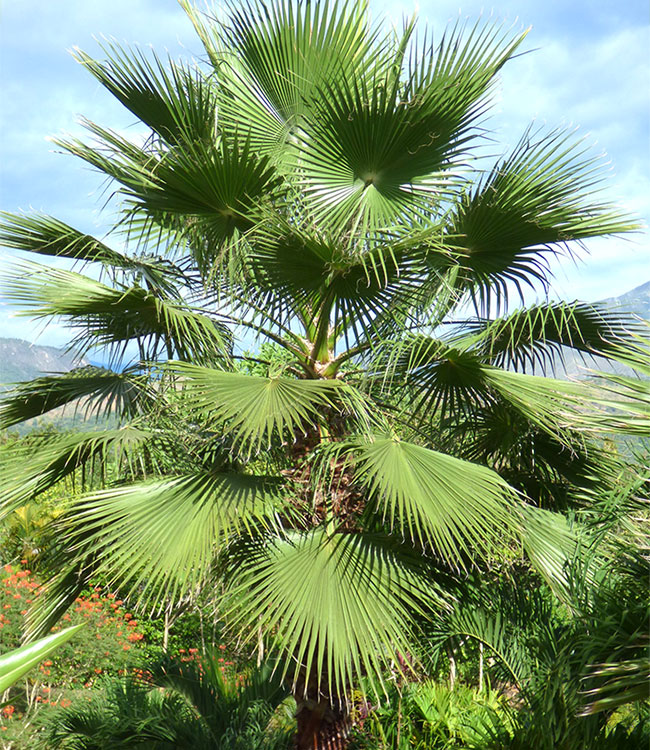
The Mexican Fan Palm, scientifically known as Washingtonia robusta, originates from the desert regions of Mexico. This palm has gained popularity among landscapers due to its durability and rapid growth rate.
Although it may not be traditionally regarded as a canopy-forming palm, it exhibits excellent tolerance to both cold temperatures and drought conditions.
The Mexican Fan Palm thrives best in well-drained acidic or alkaline soil. While it has the potential to reach impressive heights of 70 to 100 feet and spans 5 to 10 feet, it typically averages around 40 feet in height.
With regular watering and proper fertilization, its growth rate can be accelerated to approximately 2 feet per year.
8. Queen Palm Tree (Syagrus romanzoffiana)
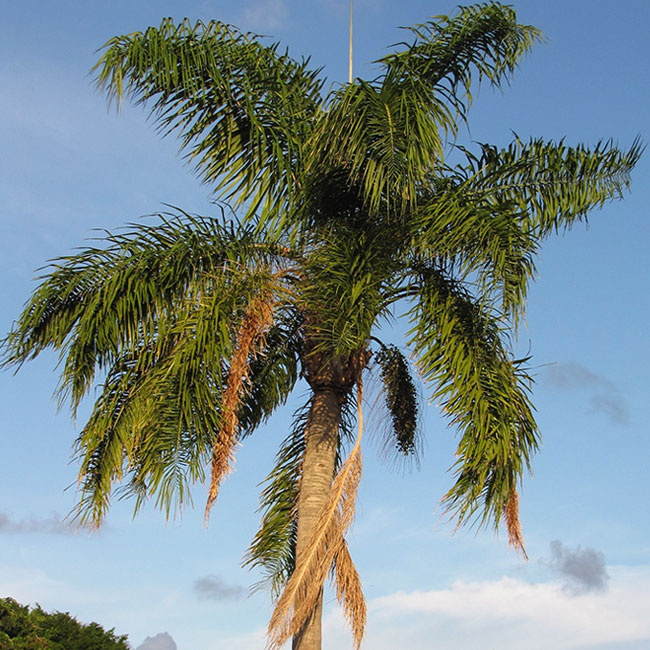
The Queen Palm, scientifically known as Syagrus romanzoffiana, originates from the woodlands of South America, specifically Brazil and Argentina. This rapidly growing palm has earned its place as one of the most beloved palm species in the United States.
It thrives in soil that is either acidic or neutral, provided it has excellent drainage. While it exhibits only slight tolerance to drought and salt, it can endure cold conditions quite well once it reaches maturity.
This majestic palm can reach heights of 30 to 40 feet and spans 5 to 10 feet in width, boasting an impressive growth rate of approximately 2.7 feet per year. If you opt for a 15-gallon plant, you can expect to have a 25-foot-tall tree in as little as 7 to 8 years.
9. Royal Palm Tree (Roystonea oleracea)
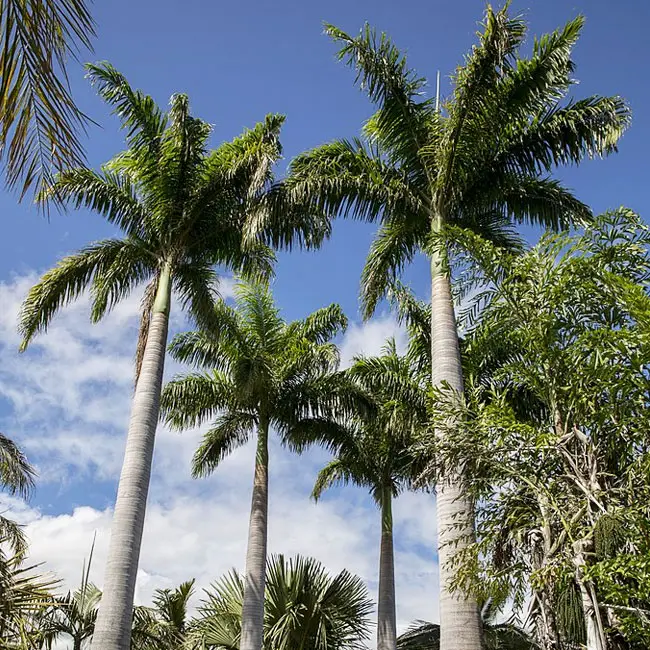
The Royal Palm Tree, scientifically known as Roystonea oleracea, is indigenous to regions including Mexico, Central America, the Caribbean, and southern Florida.
This rapidly growing palm can attain impressive heights of 60 to 70 feet and span 5 to 10 feet in width when cultivated in a warm tropical climate. However, it displays limited tolerance to freezing cold weather.
Although diseases are infrequent, potassium deficiency can occasionally arise, particularly when the palm is planted in sandy soils.
With proper care and maintenance, it has the potential to transform from a 15-gallon plant into a towering 25-foot specimen in just a decade, boasting a growth rate of approximately 2 feet per year.
10. Windmill Palm (Trachycarpus fortunei)

The Windmill Palm Tree, scientifically known as Trachycarpus fortunei, is native to central and eastern China. This versatile palm exhibits adaptability to a range of soil types, whether acidic or alkaline, provided that the soil offers good drainage.
While it can endure short periods of dryness, it truly thrives when consistently watered and nourished.
Notably, its remarkable tolerance to cold temperatures has propelled its popularity in cooler regions such as Alaska, Alabama, Delaware, Maryland, Massachusetts, Mississippi, New Jersey, New York, Oklahoma, Tennessee, and many more.
This palm species can reach heights of up to 25 feet and span 5 feet in width, boasting a moderate growth rate of around 1.2 feet per year.
Palm Tree Growth Rate Comparison
The table below illustrates the growth rates of various popular palm tree species. It’s important to note that the growth rate of each plant can significantly vary depending on the specific environmental conditions in which it is cultivated.
| Palm Tree | Max. Height | Growth Rate |
|---|---|---|
| Carpentaria Palm | 30 – 40 feet | 3 feet per year |
| Queen Palm | 30 – 40 feet | 2.7 feet per year |
| King Palm | 40 – 50 feet | 2 feet per year |
| Mexican Fan Palm | 70 – 100 feet | 2 feet per year |
| Royal Palm | 60 – 70 feet | 2 feet per year |
| Acai Palm | 40 – 50 feet | 1.5 feet per year |
| Foxtail Palm | 20 – 30 feet | 1. 5 feet per year |
| Majesty Palm | 40 – 50 feet | 1.5 feet per year |
| Windmill Palm | 20 – 30 feet | 1.2 feet per year |
| California Fan Palm | 40 – 50 feet | 1 feet per year |
What is The Fastest Growing Palm Tree
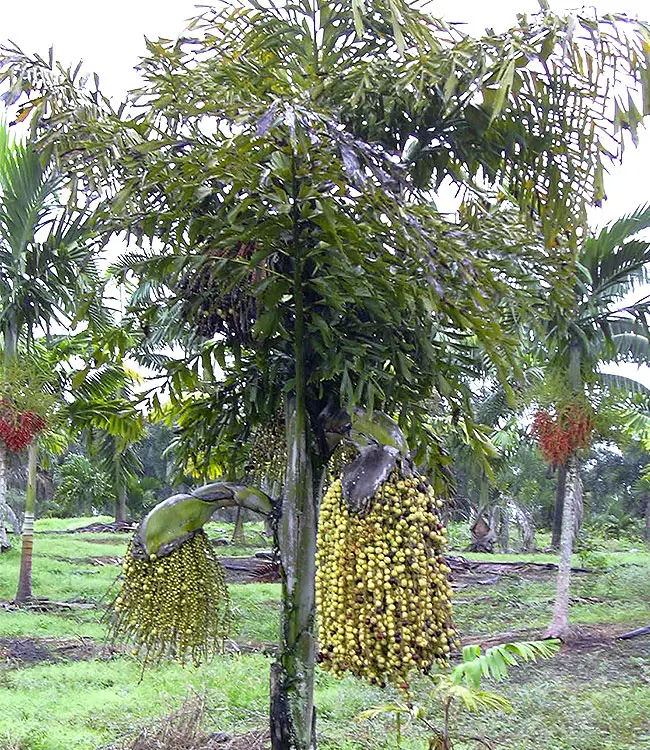
The fastest-growing palm is Caryota urens, known as the Toddy Fishtail Palm. It can remarkably transform from a 15-gallon plant to a towering 40 feet in just 5 years, boasting an impressive growth rate of approximately 7 feet per year.
Caryota urens can reach heights of around 40 to 50 feet with a spread of 10 to 20 feet. It’s worth noting that achieving this rapid growth pace necessitates consistent and diligent watering and fertilization.
Caryota urens is also recognized by several other names, including Giant Fishtail Palm, Cold Hardy Fishtail, Toddy Palm, and Kitul Palm.
An intriguing aspect of Caryota urens is its unique life cycle—it typically meets its end after flowering, a phenomenon that typically occurs after approximately 20 to 25 years.
How to Make Your Palm Grow Faster in 8 Simple Steps
To make a palm tree grow faster, it’s crucial to ensure it’s planted in the right soil, receives ample water, and gets the necessary nutrients. Keep in mind that palm trees thrive in an environment resembling their natural habitat.
- Choosing the Right Palm Species: Selecting the appropriate palm species for your specific region plays a pivotal role in simplifying palm care. As a general guideline, palm trees tend to grow faster in environments that mimic the tropical conditions they thrive in.
For instance, if you reside in Southern California, it’s advisable to opt for the Mexican palm rather than the Coconut palm. Mexican palms are better suited for low humidity environments and exhibit faster growth. - Soil Selection: The soil you choose is another critical factor in ensuring the successful establishment of your palm tree. If a particular palm species thrives in acidic soil, avoid planting it in alkaline soil, as it will struggle to flourish.
Don’t hesitate to amend the soil if necessary. Here is more information on how to select the right soil for palm trees. - Drainage Importance: Excellent drainage is imperative regardless of the type of palm you intend to cultivate. All palm varieties favor well-drained soil, so it’s essential to test the drainage before planting.
If the drainage proves inadequate, enhance it by incorporating sand, and rocks at the hole’s base, or even installing drainage pipes to divert excess water. - Minimizing Transplant Shock: Minimizing transplant shock is crucial for helping your palm acclimate to its new surroundings more rapidly.
Before planting, acclimatize your plant and disturb its roots as minimally as possible. My post on reducing transplant shock offers numerous valuable tips for this process. - Sun Protection: Sun protection is a key consideration, especially for young palm plants. Even if a palm species typically thrives in full sun, it’s advisable to shield young plants from direct sunlight until they mature enough.
- Regular Watering Schedule: Maintaining a regular watering schedule is one of the cornerstones of palm tree care.
While some palm varieties are highly drought-tolerant, others can only withstand dry conditions for a limited time. Here is my in-depth guide on when and how to water your palm trees. - Regular Feeding Schedule: Another critical factor in determining the growth rate of your palm is adhering to a regular feeding schedule.
Supply your palm with high-quality slow-release fertilizer three to four times a year to ensure it receives all the necessary nutrients. I’ve compiled a list of the best fertilizers and essential nutrients for palms in a separate post. - Cold Protection: Cold protection may not be necessary in tropical climates. However, for young plants that haven’t fully adapted to their new location and are susceptible to low temperatures, various cold protection methods are available, as detailed in my post over here.
Related articles:
–Top 10 Most Popular Florida Palm Trees (with Pictures)
–Top 35 Types of Palm Trees (with Pictures)
-Identify Over 2,500+ Types Of Palm Trees (with Pictures)
–How To Plant A Palm Tree In 10 Easy Steps (with Pictures)

I have 22 queen palm trees in my yard and side lot. All healthy and maintained. A few weeks ago one of our beautiful, mature queen palms died SUDDENLY! Within two days all the green frons were drouped and broke at the top and some were drouped and touching the grass. This queen palm went from looking magnificent to lifeless (still green) and being totally dead within a week. The frons have now, of course, turned brown. Our trees are injected yearly for prevention of white flies and also fertilized by a tree service. Any idea what could have caused this??
I’m moving to punta gorda on Tuesday I have a blank slate yard to start a beautiful landscape please help
Lisa: First: Google Florida Palm Trees. It gives and shows you a comprehensive list of the different types of palm trees to help you decide the size, shape of the various palm trees for shade, etc. Otherwise you will get zonkered on trees and bushes you really dont want. Read/study it thoroughly over first to give you ideas as to what YOU FEEL you want before asking anyone to sell you a lot of ‘everything’ you dont want..
Then when you feel strongly confident as to your type of trees, bushes, hedges visit your local tree sellers and tell them what YOU want…and save yourself tons of dollars ascwell as feel good about yourself.
Good luck!
Ted